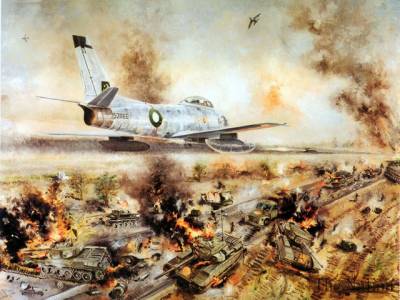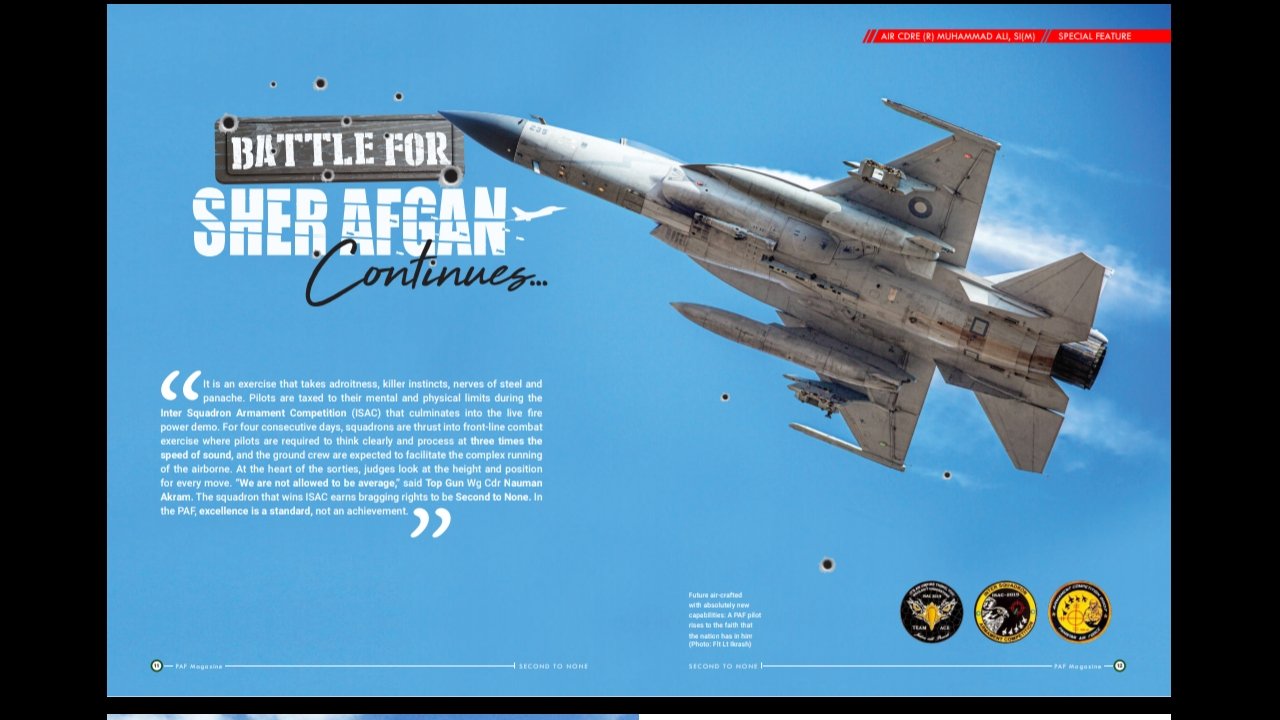Corax
FULL MEMBER

- Joined
- Feb 20, 2022
- Messages
- 642
- Reaction score
- -16
- Country
- Location
,.,..,
1965 Pakistan-India War:
Three AAAs that saved Pakistan – ALLAH, Artillery, and the Air Force
Admin PSF
September 7, 2021

1965 war witnessed the rattling of two air-forces ratioed 1:5 means every single fighter aircraft of Pakistan Air Force was had 5 opponents to fight against. No other option was there other than to defend the homeland from the cowards who opened the war front in the darkness of a night.
They aimed to capture Lahore in a day, but they underestimated the sons of soil, the rigid nerves of men in uniforms, ready to embrace death in the defense of the motherland. The intense air battles resulted losses on both sides but the heroics of PAF were remarkable enough to be mentioned in the books of history.
Although the war broke out on 6th September, but PAF was put on red alert by the visionary leadership of Air Marshal Nur Khan. This helped PAF attaining upper hand and virtual control of whole war, it greatly facilitated in preparing the PAF for imminent war. As the war broke, PAF adopted a very offensive strategic plan of crippling IAF on ground through air strikes on their airfields.
Meanwhile they also carried extensive ground support by pounding the advancing armored columns of Indian Army. IA opened fronts at Lahore, Kasur & Sialkot with tanks, artillery guns, armored vehicles, and infantry support. On 6 September, the 15th Infantry Division of the Indian Army, under World War II veteran Major General Niranjan Prasad, battled a massive counterattack by Pakistan near the west bank BRB Canal. He made two attempts to cross the canal and enter the Lahore city but was stopped by resilience and resistance of Pakistan Armed Forces. 3rd Jat division of Indian Army was able to cross the BRB and capture the village of Batapur near Jallo-More of Lahore, but the sharp shooters of PAF destroyed their ammunition stores and armored vehicles, which shattered their morale and they had to retreat.
PAF had F-104 starfighters for high altitude flight and to provide cover to the low flying F-86 Sabers. PAF had 125 F-86 Sabre, a dozen or so F-104 Starfighters and around 27 B-57 Canberra Medium Bombers.
IAF possessed some 26 fighter squadrons and four medium bomber squadrons. It deployed IAF could deploy only one MiG-21 squadron which had only a handful of aircraft on its strength; five Mystere Ground Attack squadrons, three Hunter Fighter G/A squadrons, three Gnat Mk1 Air Defense squadrons; three Canberra medium bomber squadrons and two reformed and merged Vampire squadrons, which were withdrawn when four Vampires were lost on the first day of operations against Pakistan.
The employment of PAF assets was accomplished in a very innovative and professional manner. Single squadron of PAF F-104s managed to attain and maintain air superiority throughout the conflict. The Star Fighters were employed as top cover for the F-86s representing a threat to the IAF fighter fleet. Resultantly, brilliantly flown PAF Sabers inflicted more losses on the IAF Hunters, Gnats and Mysteres.
The employment of the Bomber fleet was also very well panned by the PAF top leadership. Besides the fighters, the bombers also made significant contributions by undertaking regular night bombing operations against several Indian airfields, damaging most of them. PAF leadership also exhibited a classic example of unconventional means of utilizing its C-130 fleet for night bombing.
The speed with which the idea was adopted, and the necessary modifications incorporated reflected the PAF’s pilots and engineer’s genius for improvisation
PAF was outnumbered in comparison to the IAF, yet it had superiority in terms of training which pilots were undergoing for 8 years with Americans. PAF’s B57s were also better than the Indian English Electric ones with superior avionics and upgradation package.
Prior to the full front war, Flight Lieutenant Imtiaz Ahmad Bhatti and Squadron Leader Sarfaraz Ahmad Rafiqui gave a bloody nose to IAF Vampires on September 1, when two PAF F-86 Sabre shot four IAF Vampires, when they were attacking army in Chamb area. Post this, no Vampire was seen in the rest of the war.
Squadron Leader Sarfaraz Ahmad Rafiqui was in command of three F-86 aircrafts in the strike against Halwara airfield on September 6. His guns were jammed for some unknown reason, Rafiqui, unarmed as he was, refused to give up and continued instead to provide protection to his co-fighters while ordering his wingman to take over as leader. Although, his aircraft was shot down. However, he did allow others to hit three more of hunters of IAF, which had intercepted them in their strike. Given his exemplary leadership in each of his exploits, he has been honored with Sitara-i-Jurat and Hilal-i-Jurat. In another heroic attempt,
PAF Pilot Muhammad Mehmood Alam shot Five IAF Hawker Hunters in less than 60 seconds, making it a world record yet to be broken. He was awarded with Sitara-e-Jurat
In reaction to the Indian thwart against Lahore on 6th September, PAF responded with preemptive attacks on Indian airfields at Pathankot, Adampur and Halwara. Pathankot was a great success for PAF as around 10 Indian aircrafts were destroyed on ground by PAF pilots.
The best day for PAF was to defend Sargodha, the central fort for the Air Force, against the Indian charge and thwart to destroy the center of operations. PAF defended the fort with a great courage, a small force against a 3-5 times larger enemy in numeric, but it was the training of PAF Pilots, the spirit of Eeman and the patriotism which made them a rigid wall of defense and Indian attempts were neutralized.
All in all, the war was ruled by PAF virtually in the skies as India lost around 75 aircrafts (110 claimed by Pakistan) in the cost of mere 20 aircraft losses by Pakistan. There is a famous saying of an Indian Pilot:
Four 'A's, forgetting Amreeka.












